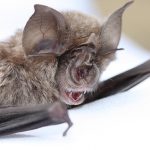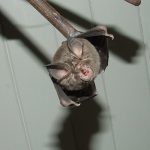EASTERN HORSESHOE BAT
The Eastern Horseshoe Bat – Nature’s Twilight Navigator
In the quiet hush of an Australian evening, just as the first stars prick the sky, a small shadow flits across the fading light. If you could see it up close, you’d notice something remarkable: a delicate, leaf-like structure resting over its nose — shaped like a tiny horseshoe. This is the Eastern Horseshoe Bat, a master of the night sky and an unsung guardian of insect balance.
Appearance and Adaptations
The Eastern Horseshoe Bat is instantly recognisable by its horseshoe-shaped nose leaf, a specialised fleshy structure that plays a vital role in echolocation. This adaptation allows it to send out precisely shaped sound waves, which bounce back from surrounding objects and prey.
- Wingspan: 30–35 cm
- Fur: Soft grey-brown, blending perfectly with the subdued colours of dusk and early night
- Echolocation: Ultrasonic calls, inaudible to human ears, but a rich and complex language in the bat’s world
When in flight, its wings slice silently through the air, its body streamlined for manoeuvring between trees and undergrowth.
Range and Habitat
The Eastern Horseshoe Bat lives along the eastern coastline of Australia, stretching from the tropical north of Queensland, through New South Wales, and into the cooler reaches of Victoria.
It thrives in:
- Rainforests – dense, humid, and full of insect life
- Woodlands – offering open hunting areas and roosting hollows
- Suburban fringes – where old buildings, caves, and even abandoned mines provide shelter
During daylight hours, they roost in colonies, often clinging to the ceilings of caves or tucked away in thick vegetation.
Life After Sunset – Hunting and Diet
As night falls, the Eastern Horseshoe Bat becomes a precision aerial hunter.
- Primary prey: Moths, beetles, and other flying insects
- Hunting method: Using echolocation to detect even the faintest flutter of insect wings, then swooping in with acrobatic skill
By consuming large quantities of insects, they help maintain ecological balance, making them an important ally to farmers and natural ecosystems alike.
Breeding and Life Cycle
- Breeding season: October to December (spring to early summer)
- Offspring: Usually a single pup each year
- Development: Young are born blind and helpless, depending entirely on their mother for warmth and milk until they can fly and hunt on their own
- Lifespan: 5–8 years in the wild, though survival is influenced by predators, food availability, and environmental conditions
Conservation Status
- IUCN Red List: Least Concern
- Threats: Habitat destruction, human disturbance in caves and roosting sites, and changes in insect populations due to pesticide use
- Conservation measures: Preserving roosting habitats, minimising disturbance during breeding seasons, and protecting insect-rich ecosystems
Though not currently endangered, their future depends on maintaining the delicate habitats they rely upon.
A Symphony Beyond Human Hearing
While we cannot hear their calls, each Eastern Horseshoe Bat fills the night with an ultrasonic chorus of clicks, pulses, and frequency modulations. These sounds create an acoustic map of the world around them — a sensory experience as rich to them as sight is to us.
Imagine standing at the mouth of a cave at dusk, watching hundreds of these bats stream out together. It’s like a living ribbon unspooling into the night — a reminder of life’s quiet wonders.
Why They Matter
The Eastern Horseshoe Bat is more than just a nocturnal marvel. It is:
- A natural pest controller, reducing the need for chemical insecticides
- A vital link in the food web, supporting predators and pollinators alike
- A symbol of adaptation, perfectly tuned to its environment over millions of years
By learning about and valuing bats, we take a step towards protecting the intricate balance of Australia’s ecosystems.


